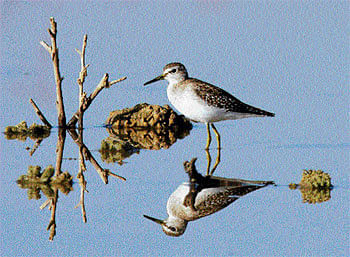Shidlaghatta, a town in Chikkaballapur district, that boasts of having Asia’s second biggest cocoon market, is also a safe haven for migratory birds, Spotted Sandpiper and Little Ringed Plover, during winter.

A small shorebird, 18 to 20 cm long, Spotted Sandpiper and Little Ringed Plover of the wading bird group can be spotted at Ammanikere on the outskirts of Shidlaghatta.
The Spotted Sandpiper, which breeds near fresh water across most of Canada and the United States, migrates during the winter.
Not gregarious
The winged guests, which are not gregarious, can be seen foraging for food in the tank. The birds, which catch insects, can be recognised by their constant nodding and teetering.
As the water level in Ammanikere has depleted due to low rainfall, the birds can be seen picking food from puddles of water.
Spotted Sandpipers that generally nest on the ground have short yellowish legs and orange bill with a dark tip. While, Little Ringed Plovers have grey brown back and wings, a white breast with one black neckband. Its legs are flesh-coloured and toes are all webbed. Akin to the Spotted Sandpiper, they too nest on the ground with little or no plant growth and lays three to four eggs.
Gender equality
A native to Europe and western Asia, its natural habitat is the gravel and sand banks along edges of rivers. An interesting facet of Little Ringed Plover is that both male and female take turn to incubate the eggs.
“The breeding season of both the birds extend from March to May. They migrate to India and other Asian countries when winter becomes unbearable in their native habitats. It is heartening to know that our tanks attract birds from such far-off regions. Checking pollution, preventing dumping of waste and regular de-weeding can make our tanks more hospitable for migratory and our own native species of birds,” said Ajit Kaundinya, a lecturer.